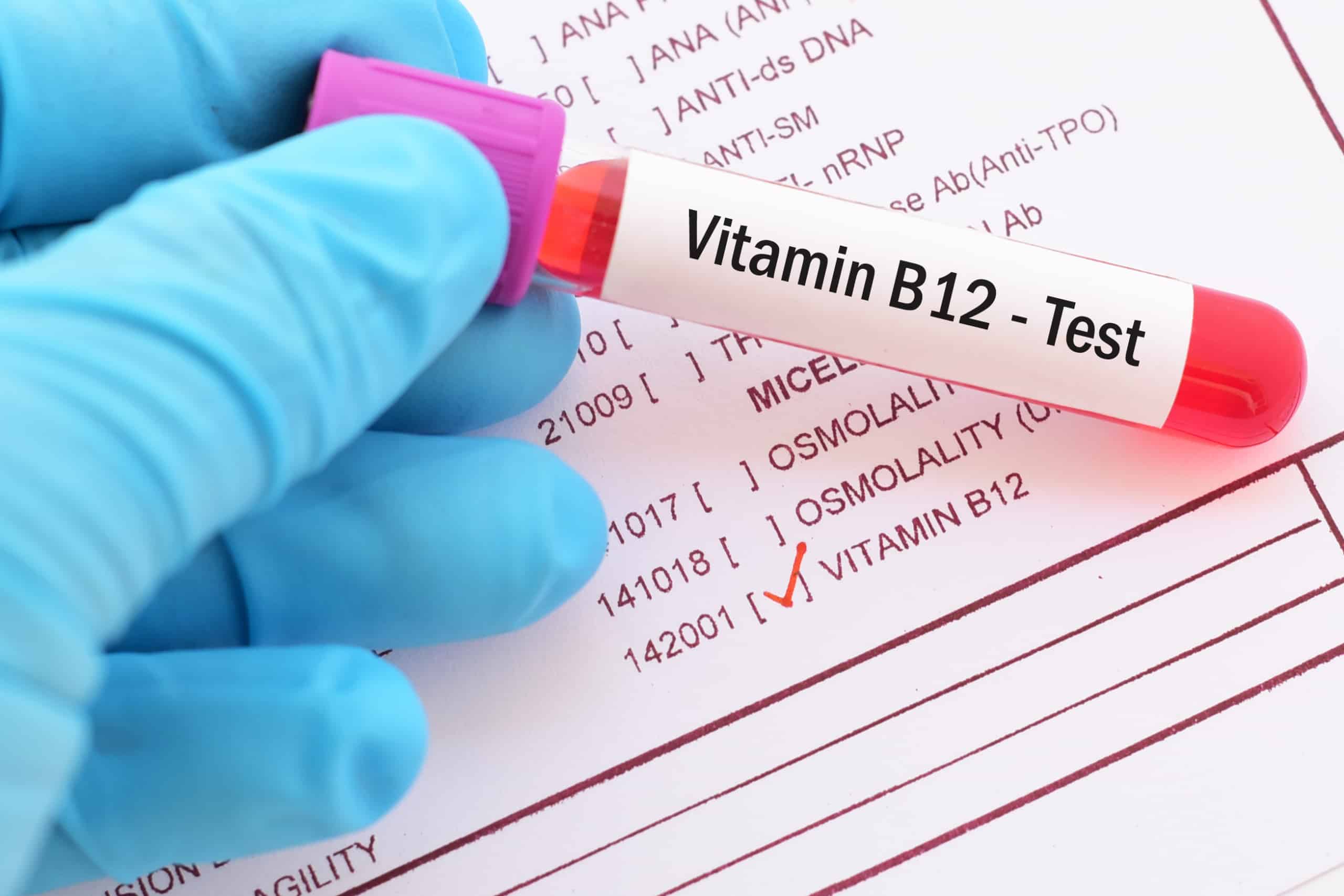Vitamin B-12 plays a key role in numerous bodily processes, including cognitive function, red blood cell formation, and healthy nerve signaling. There are a few methods to evaluate your B-12 status.
You can have blood drawn at a clinic or use an at-home urine kit. These assessments examine your circulating vitamin B-12 and levels of methylmalonic acid (MMA).
Insufficient B-12 can produce symptoms such as:
- anemia
- persistent tiredness
- palpitations
- neurological difficulties
- temporary fertility issues
Individuals who consume large amounts of red meat often show elevated B-12 concentrations. Abnormally high vitamin B-12 may indicate liver problems or particular forms of leukemia.
Vitamin B-12 insufficiency is relatively common. Around 6% of adults under 60 in the United States and United Kingdom have low B-12, while in those over 60 the prevalence approaches 20%.
Many people—especially older adults and those with gastrointestinal disorders—struggle to absorb B-12 from foods and oral supplements.
Find out whether vitamin B-12 can improve your energy levels.

When might your clinician order a B-12 test?
Your provider may suggest a B-12 test if you experience:
- numbness or tingling in hands and feet
- balance problems
- rapid heartbeat
- confusion
- cognitive decline
- muscle weakness
- reduced appetite
This test may also be ordered if pernicious anemia is suspected. Pernicious anemia is a drop in red blood cell count caused by impaired absorption of vitamin B-12 in the digestive tract, which is essential for producing red blood cells.
Pernicious anemia is uncommon in people under 30; it’s most often diagnosed around age 60.
Symptoms of pernicious anemia can include:
- diarrhea or constipation
- severe fatigue
- loss of appetite
- pale complexion
- an inflamed red tongue or bleeding gums
Elevated serum folate
Your clinician may check B-12 if serum folate is high. Elevated folate can mask a B-12 shortage and exacerbate its symptoms, according to the National Institutes of Health (NIH).
Serum folate assesses folic acid concentration in the bloodstream. Folic acid is vital for growth and development and for making red and white blood cells and platelets.
Read more about the signs of vitamin B-12 deficiency »
Who should consider B-12 testing?
The body does not synthesize vitamin B-12 on its own; it is obtained from animal-derived foods such as fish, meat, and dairy. Groups at higher risk of B-12 deficiency include:
- older adults
- infants and young children
- vegans
- strict vegetarians
- people with diabetes
- individuals who have had gastric bypass surgery
Breastfeeding mothers may wish to check B-12 levels if they have symptoms or fall into an at-risk group. If a nursing mother is deficient, her infant faces a higher risk of neurological harm and developmental delays, according to Harvard Health Publications.
Certain conditions can impair B-12 absorption. Discuss testing with your clinician if you have:
- pernicious anemia
- celiac disease, where gluten triggers immune damage to the intestinal lining
- Crohn’s disease, an autoimmune disorder causing chronic inflammation of the GI tract
- atrophic gastritis, a thinning of the stomach lining reducing acid production
Medications that can influence vitamin B-12 levels include:
- chloramphenicol (Chloromycetin)
- proton pump inhibitors like omeprazole (Prilosec) and lansoprazole (Prevacid)
- H2 blockers such as cimetidine (Tagamet), famotidine (Pepcid), and ranitidine (Zantac 360)
- metformin, a diabetes medication
Risks and side effects of a B-12 test
You may feel a quick pinch when the needle enters your arm, but blood draws are low-risk and typically cause minimal discomfort.
Some mild soreness or bruising at the draw site can occur for a few days. Contact your clinician if you experience throbbing pain or swelling after the procedure.
Notify your provider before testing if you have a bleeding disorder such as hemophilia or a history of clotting issues. Excessive bleeding at the needle site is possible in these cases.
Also inform your clinician about any prescription or over-the-counter medications you take, since some drugs can affect test results.
Types of B-12 tests and what to expect
Preparing for a blood test
Your healthcare team may instruct you not to eat or drink for about six to eight hours before the appointment. Being well-hydrated in the days leading up to the draw helps.
During the procedure, the provider will clean a small area on your arm or elbow with antiseptic.
They may place a tourniquet around the upper arm to enlarge the veins. A needle is then inserted into a vein to collect blood.
After collecting enough blood, the needle is removed and a bandage applied. The sample is sent to a laboratory to measure vitamin B-12 and other markers like holoTC.
Preparing for at-home tests
You can also test B-12 at home. Home kits are typically priced around $65 to $90 and are available online. Most home kits assess urine for MMA, a marker associated with early B-12 deficiency.
Some kits require mailing a urine sample to a lab; these include a collection container and shipping instructions. Other kits use test strips you dip into the sample and read immediately.
Understanding B-12 test results
Both low and high B-12 findings can point to underlying issues. Low B-12 may indicate:
- malabsorption
- celiac disease
- Crohn’s disease
- hyperthyroidism
- insufficient dietary B-12
High B-12 levels may suggest:
- liver disease
- certain leukemias
- renal failure
It’s also possible to have abnormal B-12 levels without other health problems. Most illnesses present with additional signs beyond altered B-12 values.
Reference ranges can differ among laboratories, so review your results with your clinician.
Vitamin B-12 result categories
Results expressed in picograms per milliliter (pg/mL):
below 150 pg/mL — low
160 to 950 pg/mL — normal
950 pg/mL — high
Managing your B-12 levels
For those with elevated B-12, management may include dietary changes, such as reducing intake of animal-derived foods like meat, dairy, and seafood.
If diagnosed with a deficiency, treatment aims to raise vitamin B-12 concentrations. Possible approaches include:
- B-12 injections, often given more frequently for severe deficiencies
- daily oral B-12 supplements, such as cyanocobalamin (a synthetic form of B-12)
- regular nasal liquid B-12 administration
- adopting a diet rich in vitamin B-12
If an underlying medical condition causes the deficiency, your clinician will outline additional treatment options.
Foods to prevent B-12 deficiency
While some deficiencies stem from medical issues, you can take preventive steps—especially important for vegetarians and vegans—by watching your diet.
One serving of fortified breakfast cereal can provide between 25% and 100% of your daily requirement, depending on the product. Three ounces of cooked salmon may supply more than a substantial portion of your daily need.
Other sources of B-12 include:
- seafood
- liver, pork, and beef
- chicken and other poultry
- fortified soy milk
- dairy products like milk, yogurt, and cheese
- dietary supplements
Some soy foods, such as miso, might contain B-12, but usually not in significant amounts.
Recommended vitamin B-12 intake
The required amount of B-12 varies by age and pregnancy/breastfeeding status. The following daily amounts (micrograms, mcg) apply:
birth to 6 months — 0.4 mcg
7 to 12 months — 0.5 mcg
1 to 3 years — 0.9 mcg
4 to 8 years — 1.2 mcg
9 to 13 years — 1.8 mcg
14 to 18 years — 2.4 mcg
adults 19 and older — 2.4 mcg
pregnant women — 2.6 mcg
breastfeeding women — 2.8 mcg
Although high B-12 levels can signal other health issues, consuming large amounts of vitamin B-12 does not appear to cause harmful effects.


















Leave a Reply
You must be logged in to post a comment.